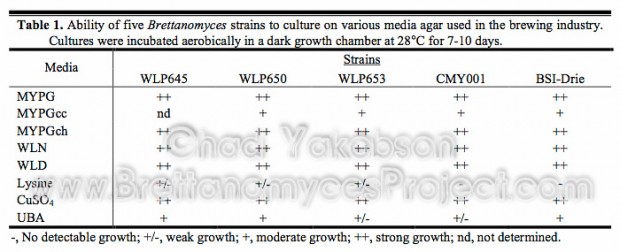Various media agars were observed for their ability to isolate and enumerate five strains of Brettanomyces. The strength of colony growth was judged based on the time it took for single colonies to develop with distinguishable morphological traits and the ease with which each medium could be used to enumerate and identify strains. During the study, strong growth was observed in all five strains with MYPG, WLN, and CuSO4 agar medias (Table 1). Medias containing 10 mg/l of cycloheximide (MYPGch, WLD) showed strong growth, comparable with the parent medium not containing cycloheximide. Lysine agar showed weak growth, and was unable to culture multiple strains.

It was found that colonies took upwards of seven to ten days for development on media agar suitable for Brettanomyces spp. and 14 days for development of giant colony morphological traits. This is in agreement with the findings of Suzuki et al. (2008) who found an incubation period of seven days was useful for the cultivation of hard to culture strains in breweries. They also found malt-based media agars to be less affected by beer adaptation occurring in strains of Brettanomyces.
Malt agar medium MYPG was used successfully to culture and store all Brettanomyces strains observed in this study. MYPG supplemented with 10 mg/l cycloheximide (MYPGch) was determined to be a great selective medium for culturing Brettanomyces strains, while MYPG supplemented with 2% calcium carbonate (MYPGcc), similar to Dekkera medium recommended for use by the European Brewery Convention (2005), took longer then ten days to develop distinguishable colonies and appeared to have diminutive growth compared with other MYPG media agars.
Another malt based medium CuSO4 agar responded well to culturing Brettanomyces strains. This is in accordance with van der Aa Kühle and Jespersen (1998) who found CuSO4 medium to be the most effective medium in detecting both Saccharomyces and non-Saccharomyces wild yeasts. This study found CuSO4 medium to be an effective medium for observing distinct giant colony morphologies as each strain developed with consistent characteristic traits. Giant colony morphology became the best tool for identification of Brettanomyces strains throughout the study. WLN medium was also found to be an effective, dual-purpose medium when it came to culturing strains of Brettanomyces and identification through giant colony morphology. The inclusion of bromocresol green pH indicator allowed for easy differentiation of strains due to the range of colours observed. Brettanomyces strains grown on WLN had distinct differences from one another and observable differences from Saccharomyces yeast strains, making for easy identification and enumeration if mixed cultures were to be present.
Of the media agars used in this study lysine agar was found to be the least useful as colonies failed to develop in most strains. It’s possible a key nutrient was missing as Aguilar Uscanga et al. (2000) found ammonium sulphate and yeast extract to have an important influence on growth and metabolic activity. UBA medium had mediocre growth capabilities with the Brettanomyces strains used in the study, having less defined traits observed during culturing.
